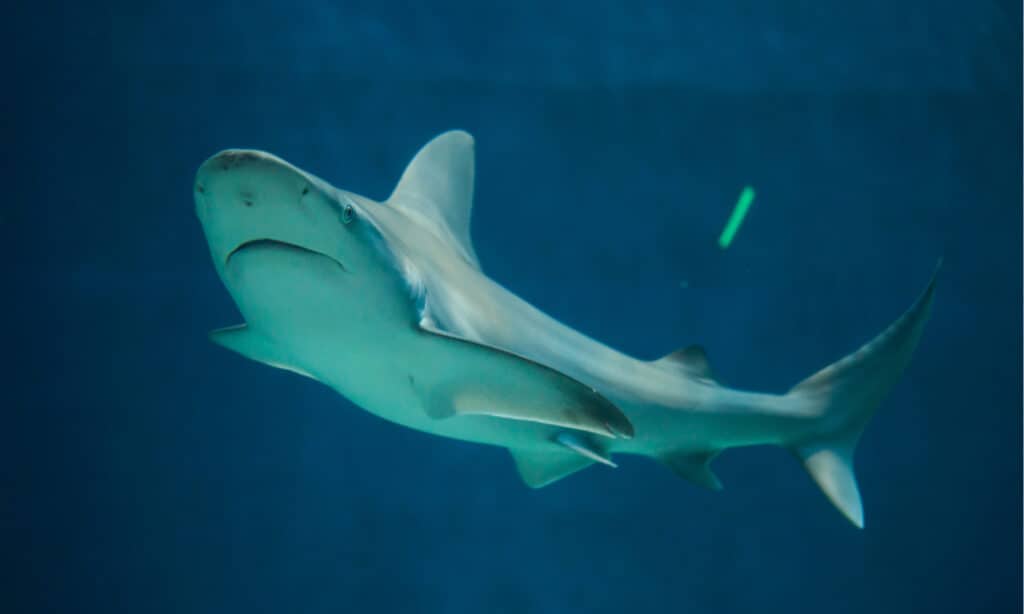The bull shark and the sandbar shark are two related shark species belonging to the huge Carcharhinidae family and the genus Carcharhinus. The bull shark bears the scientific name “Carcharhinus Leucas” while the sandbar shark is scientifically named Carcharhinus plumbeus. Despite their close familial ties, the bull shark and the sandbar shark have a range of differences and in this article, we shall be discussing them alongside some individual peculiarities. Let’s get into it.
Comparing Bull Shark Vs Sandbar Shark
| Bull Shark | Sandbar Shark | |
|---|---|---|
| Size | Length: 7ft-11.5ft Weight: 200lbs-500lbs | Length: 6ft average Weight: 110-150lbs |
| Appearance | Short snouts, light gray/dark gray dorsal side, white ventral side, small eyes, large first dorsal fin, large pectoral fins, highly serrated and triangular teeth | Large first dorsal fin, large pectoral fins, interdorsal ridge between dorsal fins, triangular/serrated teeth, gray-brown dorsal side, and light brownish gray to white ventral side. |
| Location and Habitat | Location: Along the coasts of the U.S, Mexico, Africa, India, Australia, Central America, and South America Habitat: subtropical and tropical waters; average depths of 98.43ft but can go as deep as 492.13ft. | Location: Western Pacific, western Indian, Eastern Indian, western Atlantic, and eastern Atlantic Oceans. Habitat: sandy areas in bays, estuaries, and river mouths as well as banks offshore. |
| Diet | Carnivorous; stingrays, catfishes, sea turtles, dolphins as well as smaller bulk sharks | Carnivorous; small bottom fish, mollusks, crustaceans, small sharks, rays, etc. |
| Gestation Period and Litter Size | Period: 10-11 months Litter size: 1-13 | Period: 8-12 months Litter Size: 1-14 pups |
| Lifespan | 16-25 years | 15-21 years |
The Key Differences Between the Bull Shark and the Sandbar Shark
While they both belong to the same family and genus as mentioned earlier, bull sharks and sandbar sharks have a number of differences occurring majorly in size as well as appearance. We shall delve into these differences as well as other differences and peculiarities as we move further.
Bull Shark Vs Sandbar Shark: Size

The bull shark can measure up to 11 feet long.
©Michael Gomes/Shutterstock.com
The bull shark and the sandbar shark have not-so-massive differences in length and weight according to estimated figures. The bull shark measures between 7ft and 11.5ft in length and weighs between 200lbs-500lbs. Sandbar sharks, on the other hand, have an average length of 6ft and weigh between 110-150lbs. The figures show that the bull shark is incontestably larger in size than its cousin, the sandbar shark.
Bull Shark Vs Sandbar Shark: Appearance
The bull shark and the sandbar shark actually have similarities in appearance as you would expect from closely related species. However, there are a few differences, as will be pointed out subsequently. The bull shark has typically short snouts, a large first dorsal fin, large pectoral fins, light gray to dark gray dorsal side, white ventral surface, and triangular teeth with incredible serration.
The sandbar shark is pretty similar with a large first dorsal fin, large pectoral fins, triangular/serrated teeth, a brownish gray dorsal side, light brownish gray/white ventral surface, and a moderately long snout. They also have interdorsal ridges between their dorsal fins which is not present in bull sharks.
Bull Shark Vs Sandbar Shark: Location and Habitat
Bull sharks are located along the coasts of Mexico, the United States, Central America, South America, Africa, India, and Australia. They inhabit subtropical and tropical swaths of water and while they maintain average depths of 98 ft, they can go as deep as 492 ft. Interestingly, they are the only shark species that can endure protracted periods in freshwater areas.
Sandbar sharks have a strong presence in the Western Pacific, Western Indian, Eastern Indian, Western Atlantic, and Eastern Atlantic Oceans. They also extend to the Gulf of Mexico, the Caribbean, and the Mediterranean Sea. They prefer muddy or sandy areas and often dwell in estuaries, harbors, bays, and river mouths. They may also inhabit offshore areas as well as banks proximate to flat reefs.
Bull Shark Vs Sandbar Shark: Diet

Sandbar sharks include crustaceans, skates, and
anchovies
in their diet.
©Vladimir Wrangel/Shutterstock.com
The bull shark and the sandbar shark have a predominantly carnivorous diet as anyone would expect. Bull sharks love to prey on sea creatures including stingrays, catfishes, sea turtles, dolphins, and even smaller bull sharks occasionally. Meanwhile, sandbar sharks are content with small bottom fishes, mollusks, crustaceans, rays, small sharks, skates, anchovies, sardines, and porcupine fishes, among others. There is no record of cannibalism among sandbar shark species.
Bull Shark Vs Sandbar Shark: Gestation Period and Litter Size
The bull shark and the sandbar are both viviparous. However, slight differences occur in their gestation periods and litter size, and there are some other individual peculiarities.
Bull sharks are typically polygynandrous, which means they often have multiple mating partners. Breeding season occurs between April and June; gestation takes anywhere from 10-11 months. Also, litter size can be as little as 1 and as much as 13 and they are nourished viviparously, i.e., internally through a yolk-sac placenta. Also, bull sharks typically keep their young in estuaries where they can access food and enjoy protection from predators.
Sandbar sharks are also polygynandrous; breeding months vary depending on geographic locations, although it usually occurs during the warmer months. The gestation period is about 8-12 months and litter size ranges from 1-14 pups, depending mostly on the size of the mother.
Bull Shark Vs Sandbar Shark: Lifespan

Bull sharks can live up to 25 years.
©Willyam Bradberry/Shutterstock.com
The bull and sandbar sharks have different life expectancies, but the figures are not so far off. While the sandbar shark is expected to live around 15-21 years, the bull shark can live anywhere between 16-25 years. This makes the bull shark a bit more long-lasting than the sandbar shark.
Up Next:
- 10 Sharks in the Mediterranean Sea
- The 5 Biggest Sharks Near Alabama Beaches
- Bull Shark Location: Where Do Bull Sharks Live?
The photo featured at the top of this post is ©
Thank you for reading! Have some feedback for us? Contact the AZ Animals editorial team.






